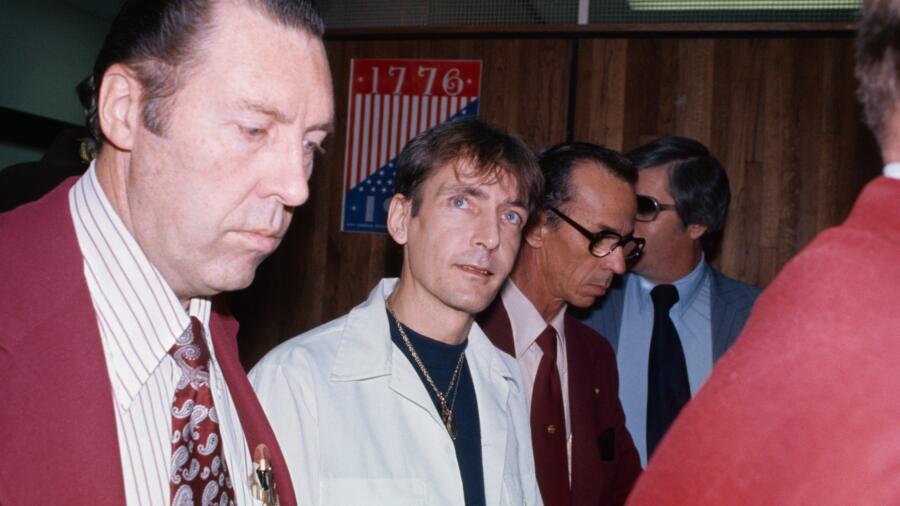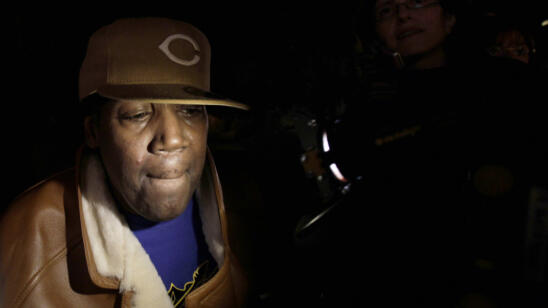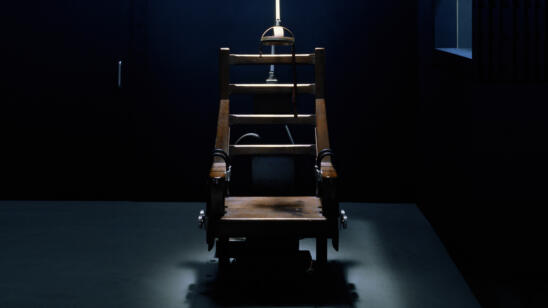It was heartbreaking and frightening for residents of Utah County, Utah in July 1976 when two young Mormon men were shot dead in back-to-back robberies.
But the killer, Gary Gilmore, was captured within hours. He made a confession and a key witness was found. While tragic, it seemed as if the two crimes would have a quick resolution, journalist Tom Haraldsen tells A&E True Crime.
“We had no idea what this was going to become,” explains Haraldsen, who reported on Gilmore’s murder spree and trial at the time for the Daily Herald newspaper in Provo.
That October, Gilmore was convicted and sentenced to death. The 35-year-old, an abused child who spent much of his life in prison, not only accepted his fate—he chose to die by firing squad.
The decision made Gilmore the first person to be executed in the United States since the Supreme Court struck down the death penalty in 1972.
Gilmore became an international celebrity, scorning attempts to spare his life.
On January 17, 1977, while protestors rallied outside Utah State Prison, Gilmore was strapped into a chair. Behind a screen, five men raised their rifles. “Let’s do it,” he said.
[Read more last words of death-row inmates.]
‘Begging Him to Stop’
“My father was the first person I ever wanted to murder,” Gilmore said, according to Shot in the Heart, a memoir by his youngest brother Mikal Gilmore.
Their father Frank Gilmore, an alcoholic who sold ads for magazines, frequently uprooted the family. Unpredictable and violent, he used a razor strap to beat Gary and Frank Jr., the two eldest of four sons.
“He’d keep swinging and swinging and swinging and Gary kept yelling and crying and begging him to stop, which would only make Dad hit him harder,” Frank Jr. recounted in the book.
The abuse set Gilmore, a talented artist with a high IQ, on a self-destructive path, according to Mikal. In his teens, Gilmore risked his life racing freight trains and stole cars for kicks.
At age 15, Gilmore was sent to a tough reform school. He emerged a year later “fully committed to living a criminal’s destiny,” Mikal said.
That proved true in 1962 when Gilmore was convicted of armed robbery and assault. In prison, he constantly resisted authorities and attempted suicide. His violent outbursts prompted authorities to administer powerful anti-psychotic drugs.
In spring 1976, relatives intervened to parole Gilmore. “He’s paid his dues,” his cousin Brenda Nicol is quoted saying in Norman Mailer’s The Executioner’s Song, a Pulitzer Prize-winning true crime novel about the case.
An uncle provided Gilmore with a job in Provo, Utah, where he fell in love with Nicole Baker Barrett, a thrice divorced 19-year-old with two young children.
But life in small-town Utah was fraught for Gilmore. He drank heavily, and his violence caused Baker to leave, triggering a spiral of rage.
A Flip of a Coin
Max Jensen, 24, didn’t want an unexpected late shift at the gas station where he worked in Orem, Utah, on July 19, 1976.
The Brigham Young University student “lost a flip of a coin with the assistant manager,” Haraldsen recalls.
That afternoon, he’d heard Jensen and his wife, Colleen, speak at a Latter-day Saints gathering.
“It was about honesty,” Haraldsen says. “The challenge of being honest.” Jensen finished at the gathering, went to work and was Gilmore’s first victim.
Jensen was alone when Gilmore entered the station and pulled out a stolen automatic pistol. “This one is for me,” Gilmore told Jensen, before firing, according to The Executioner’s Song. Then, “this one is for Nicole.”
The next night, Gilmore walked into the City Center Motel in Provo, and demanded the cash box from manager Bennie Bushnell, also a student at Brigham Young.
Neither of the two students resisted Gilmore. They lay on the floor as ordered and were both shot in the head.
Asked by a detective why he killed Jensen and Bushnell, who had one son and a pregnant wife, Gilmore said. “I don’t know. I don’t have a reason.” Later he added, “I can’t keep up with life,” Mailer recounted.
‘He Didn’t Want a Trial’
Defense attorney Michael Esplin first met Gilmore in a jail cell shortly after the murders. “He still had a bandage on his hand. He was not a very good criminal,” Esplin tells A&E True Crime. “He shot himself with his own gun and left a trail of blood, and he did it in front of a star witness [who was a motel guest].”
Gilmore made it clear he didn’t want a trial, Esplin recalls. “He said, ‘I want to plead guilty.'”
Esplin and a colleague explained, “‘they’re not going to just allow you to just plead guilty. This has consequences beyond just your case.'”
Eventually, Gilmore “flipped the switch,” on his original plan, Esplin says.
“He liked to go to court. He liked being the center of attention. He thought it was a way to get his girlfriend back. He saw this trial as a way to at least have some contact with her.”
When Baker was sitting near him, Gilmore “would turn around, making goo-goo eyes and blowing kisses,” Esplin remembers.
When Gilmore went on the stand against legal advice, “the county attorney eviscerated him,” Esplin says. Instead of evoking sympathy, Gilmore was curt, unemotional and gave “no explanation” for his actions.
On October 7, 1976, Gilmore was convicted and sentenced him to death. Given a choice of hanging or the firing squad, he said, “I’d rather be shot.”
Haraldsen, who was in the courtroom, recalls Gilmore “wasn’t shocked at the verdict. He didn’t seem angry. He seemed pretty emotionless.”
‘He Went Off on Us’
Esplin recalls meeting with Gilmore in a locked cell to discuss his appeal with a colleague and that it was the was the only time interacting with Gilmore where he felt nervous. “He went off on us cursing, then calmed down and said ‘what can I do?’,” Esplin says.
What Gilmore did was hire new lawyers. Despite efforts from the American Civil Liberties Union and his mother, Bessie, to stop the execution, Gilmore prevailed.
From prison, Gilmore mailed emotional letters to Baker. “Angel, no man ever loved a woman more than I love you,” he wrote.
A suicide pact sent both to separate hospitals in December 1976 after they each overdosed on sleeping pills. (Baker had smuggled some in to give Gilmore.)
For forensic psychologist and author Joni Johnston, that pact with the woman he loved is a telling indicator of Gilmore’s character. “If you love somebody, would you ask them to kill themselves for you?” she asks A&E True Crime.
Control Over Death
Gilmore’s execution had lasting effects. “[It] signaled a resumption of the death penalty that continues even through today,” University of Utah criminal law professor Paul G. Cassell tells A&E True Crime.
At a hearing for a new trial on November 1, 1976, Gilmore testified he did “not care to languish in prison for another day.”
Johnston surmises that Gilmore thought execution by firing squad was a more “dignified” way to die than hanging. “He really wanted to have some control over what was happening to him.”
Gilmore’s uncle Vern told the Deseret News in 1977 that the violent death was his nephew’s way of showing he wasn’t a coward and “he really wanted to atone for what he did.”
Ultimately, “if he’d been willing to raise objections to his death sentence” along with hundreds of Death Row inmates, “he would probably be forgotten today,” Cassell says.
Related Features:
Cooking Up the Last Meals of Death Row’s Most Notorious Killers
Rickey Ray Rector, The Death Row Inmate Who Lobotomized Himself


